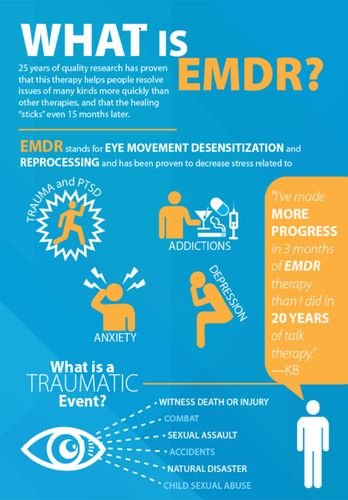EMDR (Eye Movement Desensitization and Reprocessing) is a type of therapy that is used to treat post-traumatic stress disorder (PTSD) and other psychological conditions that stem from traumatic experiences. It was developed in the late 1980s by psychologist Francine Shapiro.
During EMDR therapy, the client is asked to recall a traumatic event while simultaneously focusing on a rhythmic stimulus, such as a moving finger or a tapping sound. This process is believed to help the brain process the traumatic memory and reduce its impact on the individual's current thoughts and behaviors.
The therapy is based on the idea that trauma can cause "unprocessed memories" that are stored in the brain in a fragmented and disconnected way. The rhythmic stimulation used in EMDR is thought to help the brain reprocess these memories so that they become integrated into the person's overall memory network in a more adaptive and healthy way.
EMDR has been found to be effective for a range of conditions, including PTSD, anxiety, depression, phobias, and addiction. However, it's important to note that not everyone responds to EMDR therapy, and it may not be appropriate for everyone. It's important to work with a qualified mental health professional who is trained in EMDR to determine if it's an appropriate treatment for your specific needs.
EMDR therapy typically involves eight stages, as outlined below:
History and Treatment Planning: The therapist will gather information about the client's history and current symptoms to develop a treatment plan. This may involve identifying specific memories or events that the client wishes to process.
Preparation: The therapist will work with the client to develop coping skills and relaxation techniques to help them manage distressing emotions that may arise during EMDR therapy.
Assessment: The therapist will guide the client in recalling a specific traumatic event or memory and identifying the negative beliefs, emotions, and physical sensations associated with it.
Desensitization: The therapist will guide the client in recalling the traumatic event while simultaneously engaging in bilateral stimulation, such as eye movements or tapping. This process is intended to reduce the intensity of the negative emotions and physical sensations associated with the memory.
Installation: The therapist will guide the client in identifying and strengthening positive beliefs and emotions related to the traumatic event or memory.
Body Scan: The therapist will guide the client in identifying and addressing any residual physical sensations or emotions related to the traumatic event or memory.
Closure: The therapist will help the client return to a state of relaxation and stability, and provide them with techniques for self-soothing and managing any distress that may arise outside of therapy.
Re-evaluation: The therapist will work with the client to assess progress and determine if any additional processing is needed for specific memories or events.

